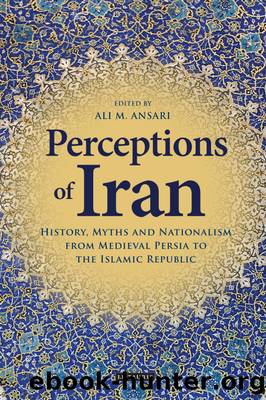Perceptions of Iran by Ali M. Ansari;

Author:Ali M. Ansari;
Language: eng
Format: epub
Publisher: Bloomsbury UK
8
Iran and the Aryan myth*
David Motadel
Few terms in modern history have developed a similar vigour and significance as the word âAryanâ. From the mid-nineteenth century onwards, the term became a strong political concept which had a notable impact on the construction of ethnic and national identities in both the European and the non-European world. This chapter presents an account of the origins, evolution and politicisation of the term âAryanâ in modern Europe, concluding with a brief sketch of its significance in the non-European world, specifically in Iran, since the late nineteenth century. The purpose of the article is to rethink the often underestimated role that Iran played in the history of myths about the âAryanâ, both in European debates and in Iranian nationalist discourse.1
The history of the term âAryanâ can be seen as a series of conceptualisations and re-conceptualisations. This chapter endeavours to draw attention to the actual change and variation in the meaning of the expression over time,2 exploring the rediscovery of the ancient term by European scholars of the late eighteenth century, its introduction into historical literature and linguistics in the early nineteenth century, and the subsequent conceptualising of âAryansâ as an Indo-European people (I); the re-conceptualising of âAryansâ as an Indo-European race (II); the evolution and abstraction of the term âAryanâ within European race theories, and its politicisation and popularisation in the late nineteenth century (III); and the political instrumentalisation, particularly discourses about the âAryanâ in Nazi Germany (IV).
I conclude with an examination of the reception of European ideas about the âAryanâ in the non-European world, specifically its reception by Iranian nationalists (V). The century-long terminological evolution of the term did result in a diversification of meaning. The following narrative should therefore not be read as a history of a linear development, or even of teleological progress, but as an accumulation of competing, though linked, meanings.
I. Origins
Two thousand five hundred years before the term âAryanâ became popular among racists and nationalists across Europe and Asia, the Persian king Darius I (522â486 bc) introduced himself in the rock inscription of Naqsh-i Rustam as follows:
I (am) Darius the great king, king of kings, king of countries possessing all kinds of people, king of this great earth far and wide, son of Hystaspes, an Achaemenid, a Persian, the son of a Persian, an Aryan, of Aryan lineage.3
The term âAryanâ, as used by Darius, was a self-designation that described belonging to a people, and conveyed an ethnical connotation. âAryanâ and related expressions like âAryaâ also appeared in other ancient Persian and Indian inscriptions and texts, most importantly in the Zoroastrian Avesta and in Vedic texts.4
The modern history of the term âAryanâ begins with two very different âdiscoveriesâ during the Age of Enlightment. The first was the rediscovery of the ancient term âAryanâ by European scholars. In the eighteenth century, when European explorers developed a rising interest in Iran and ancient Persia, they soon found out that the ancient Persians had identified themselves as âAryansâ. In 1768, before the inscription of Naqsh-i
Download
This site does not store any files on its server. We only index and link to content provided by other sites. Please contact the content providers to delete copyright contents if any and email us, we'll remove relevant links or contents immediately.
| Africa | Americas |
| Arctic & Antarctica | Asia |
| Australia & Oceania | Europe |
| Middle East | Russia |
| United States | World |
| Ancient Civilizations | Military |
| Historical Study & Educational Resources |
Machine Learning at Scale with H2O by Gregory Keys | David Whiting(3627)
Never by Ken Follett(3528)
Fairy Tale by Stephen King(2949)
The Man Who Died Twice by Richard Osman(2808)
Oathbringer (The Stormlight Archive, Book 3) by Brandon Sanderson(2630)
Will by Will Smith(2580)
Rationality by Steven Pinker(2149)
The Dark Hours by Michael Connelly(2075)
The Dawn of Everything: A New History of Humanity by David Graeber & David Wengrow(2017)
Can't Hurt Me: Master Your Mind and Defy the Odds - Clean Edition by David Goggins(2003)
Friends, Lovers, and the Big Terrible Thing by Matthew Perry(1992)
Principles for Dealing With the Changing World Order: Why Nations Succeed and Fail by Ray Dalio(1894)
HBR's 10 Must Reads 2022 by Harvard Business Review(1697)
A Short History of War by Jeremy Black(1669)
Go Tell the Bees That I Am Gone by Diana Gabaldon(1598)
515945210 by Unknown(1520)
443319537 by Unknown(1395)
Kingdom of Ash by Maas Sarah J(1386)
A Game of Thrones (The Illustrated Edition) by George R. R. Martin(1366)
